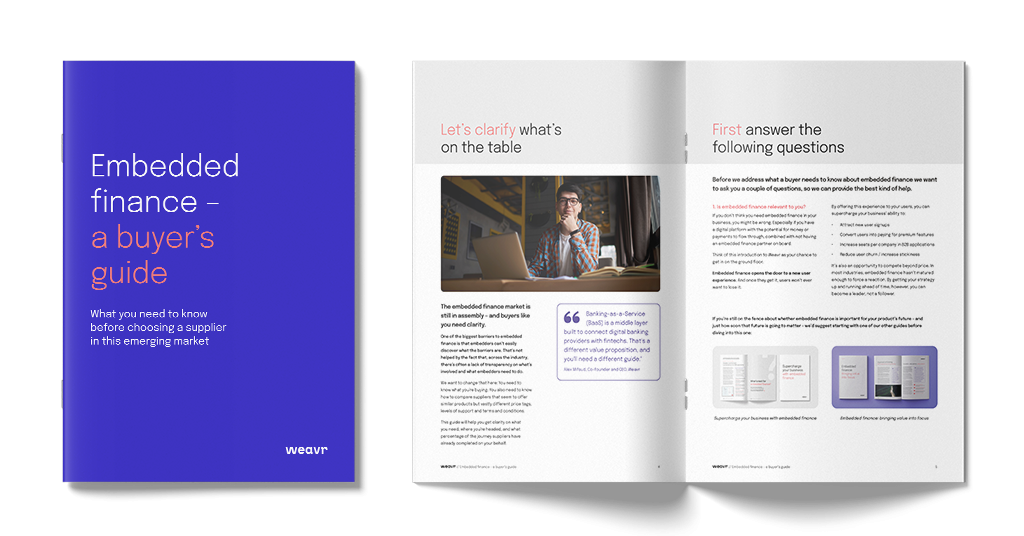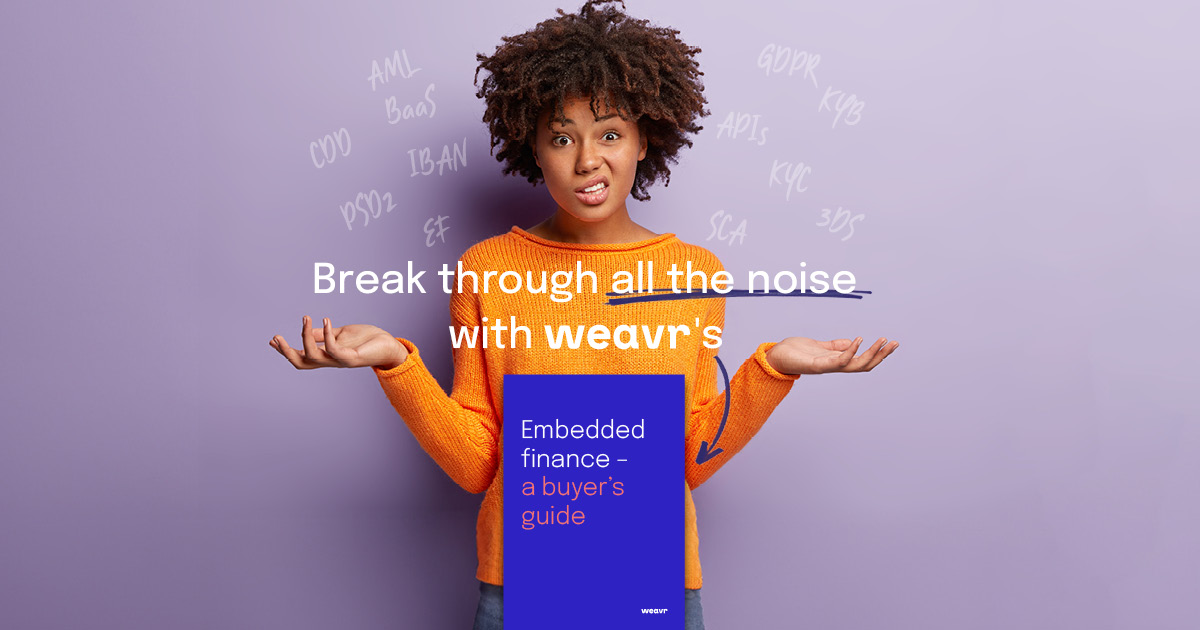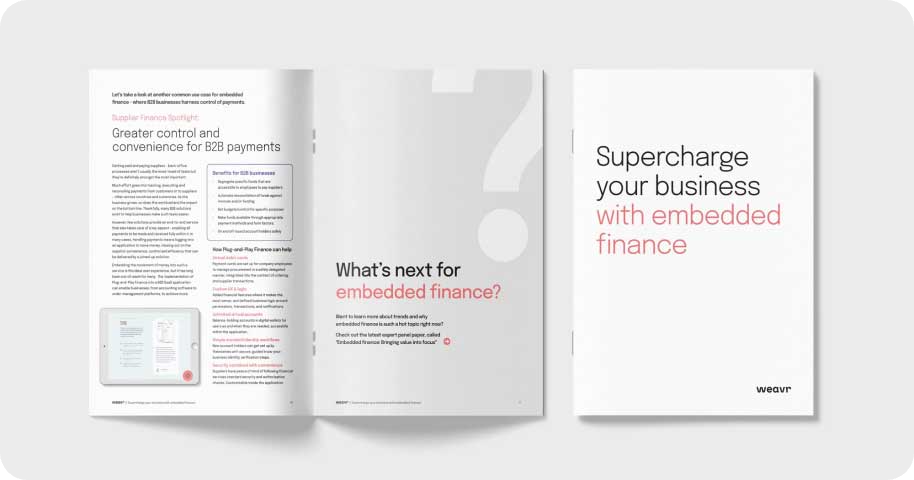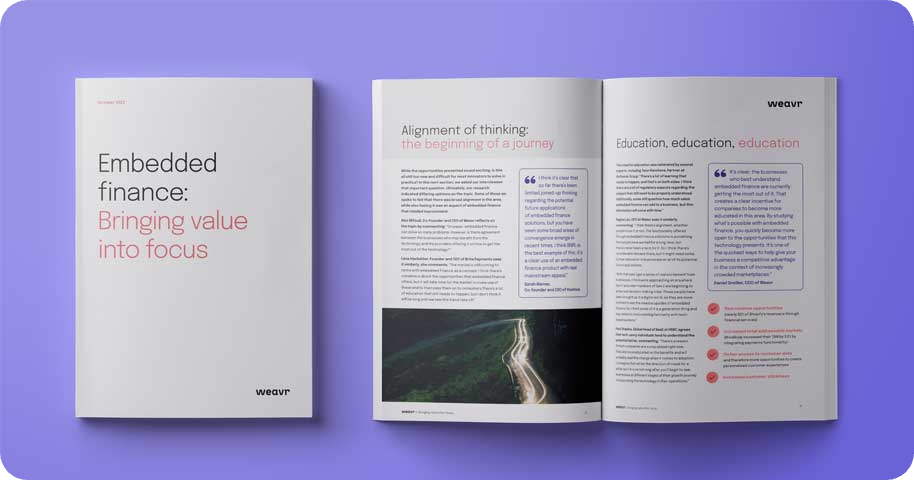- Introduction
- Where to get started with researching embedded finance
- What's on the table?
- Is embedded finance relevant to you?
- Are you a fintech business?
- Finding your embedded finance use case
- Examples of how other companies use embedded finance
- What fintech-like features do I need?
- Download the full buyers guide
Embedded finance is an emerging part of today’s digital landscape, which makes it both a potentially lucrative opportunity and also an easy place to get lost. Don’t set out without a map.
Break through all the noise with Weavr.io’s ‘Embedded finance – a buyer’s guide’
In this informative piece, you will find helpful advice to support your embedded finance journey. From design and discovery to what essential things to look out for when choosing the right supplier for you.
We’ve plotted a course through the buying journey
It’s not easy to go hunting for embedded finance.
For a start, there are a number of components that appear to be important elements of what you need, but they might not be what you need. In fact, they might lead you down rabbit holes of research and into wonderlands of confused complexity you weren’t bargaining for.

But what if getting embedded finance prototyped, implemented, and validated was a “buy” option? What if you didn’t need a complex solution? Well, we believe that will soon be the norm. And it’s what we’re pioneering with Plug-and-Play Finance. But we’re getting ahead of ourselves..
What’s on the table?

One of the biggest barriers to embedded finance is that embedders can’t easily discover what the barriers are. That’s not helped by the fact that, across the industry, there’s often a lack of transparency on what’s involved and what embedders need to do.
We want to change that here: you need to know what you’re buying. You also need to know how to compare suppliers that seem to offer similar products but vastly different price tags, levels of support and terms and conditions.
This buyer’s guide for embedded finance will help you get clarity on what you need, where you’re headed, and what percentage of the journey suppliers have already completed on your behalf.
Is embedded finance relevant to you?
If you don’t think you need embedded finance in your business, you might be wrong. Especially if you have a digital platform with the potential for money or payments to flow through, combined with not having an embedded finance partner on board.
Think of this introduction to Weavr as your chance to get in on the ground floor.

Embedded finance opens the door to a new user experience. And once they get it, users won’t ever want to lose it.
By offering this experience to your users, you can supercharge your business’s ability to:
• Attract new user signups
• Convert users into paying for premium features
• Increase seats per company in B2B applications
• Reduce user churn / increase stickiness
It’s also an opportunity to compete beyond price. In most industries, embedded finance hasn’t matured enough to force a reaction. By getting your strategy up and running ahead of time, however, you can become a leader, not a follower.
If you’re still on the fence about whether embedded finance is important for your product’s future – and just how soon that future is going to matter – we’d suggest starting with one of our other guides before diving into this one:
Are you a fintech business?
If you are a fintech (or are trying become one), your needs will be vastly different to most embedded finance use cases. For instance, you’ll want full control of development, and due to your strategic focus on crafting your own fintech solutions you’ll likely want to invest at least a year in R&D.
Do any of those describe you? If so, you’ll be after something more like banking-as-a-service (BaaS). BaaS is a middle layer built to connect digital financial services providers with fintechs.
Becoming a fintech creates a high degree of burden on your business from a regulatory point of view. If you want the benefits of embedded finance without becoming a fintech you’ll have different needs:
- You probably want to build less of the financial technology yourself
- You want to take on less compliance responsibility
- You won’t want to spend months on research or having discussions with dozens of disconnected technology and service providers
- You’ll be looking to explore your first embedded finance use cases fast, without letting it become your only focus
- You might want to solve as much as possible in a single vendor relationship
That’s a different value proposition, and you’ll need a different guide. We’d suggest starting with this: 10 questions to ask BaaS suppliers
The rest of the guide to buying embedded finance will help you to consider what questions you need to ask to get exactly what you need.
We’ll also help you to choose a supplier with your eyes wide open to all the factors involved – including compliance, financial costs and the wide differences in what suppliers mean when they say ‘embedded finance.’
Finding your embedded finance use case

Firstly, you need a focused idea of where money comes into your users’ lives. When your users are taking advantage of your application, when do they have to drop out of your UX and go and deal with payments or other money management somewhere else? These are the potential use cases which could become embedded financial flows within your application. Start by identifying those potential money flows around your product.
Secondly, you need to figure out what the end result might look like in your business since it’ll be unique to the context of your application and business vision. Which financial services best align with your product’s value proposition? How could you enhance your existing user experience? And how do you bring money-making into your platform?
For example, if your SaaS product tracks and manages suppliers and purchase orders, you might want embedded finance to make it easier to pay those suppliers.
Or, if your customers are having to leave the platform to make payments, or raise invoices, embedded finance can help reduce that friction by keeping it all in one handy place.
Getting into more detail, you might also want procurement managers using your product to be able to set controls on spending, and have a semi-automatic way of connecting those payments to approvals.
Examples of how other companies use embedded finance

Ben is an all-in-one employee flexible benefits platform with a superpower. With embedded finance, Ben could give employers the financial controls they needed, employees the power to make instant mobile wallet payments to suppliers, all while axing the admin through automatic payment reconciliation. Companies using Ben not only personalise the employee benefits they offer, they also make the benefits experience effortless.
![]()
Finway is a finance operating system that provides a way for SMEs to process, pay, plan and control spending within a company. With embedded finance, they were able to issue virtual and physical cards so employees could spend company money more efficiently within company-set perimeters complemented by smart approval processes.
![]()
corplife helps businesses of all sizes strengthen their relationships with employees and retain them long-term. How? On one hand, through exclusive employee benefits in the areas of shopping, sports, travel, gastronomy, and more. On the other hand, by providing tax-free meal allowances. To achieve these goals, corplife has developed two innovative IT solutions: corplife Benefits and corplife Lunch. The commitment to HR managers is to enhance employee satisfaction, loyalty, and productivity.
So what fintech-like features do I need?
You might not know exactly how to take your product feature ideas further. You might not be clear on how to map your use cases out in terms of financial products, or in terms of the technology you need to realise your vision.
That’s perfectly normal at this stage.
An embedded finance provider will be able to help you join the dots here but, in case you’re interested, here are some examples of the kind of things that you might need:
- Digital wallet accounts
- Personal payment cards
- Instant peer-to-peer payments
- Cash withdrawals
- Controlling rules or limits for payments
- Company (Commercial) payment cards
- Receiving payments
- Sending payments
- Authorising or improving payments
- Extracting or combining payment data
If you know exactly what you need from this list, you’re ahead of the game. But you don’t need to be stuck here, building only from the basic elements of financial products and payments.
It’s like this: you don’t need to go to your doctor with a list of suggested diagnoses and treatments – you’d be wary of any doctor who demanded you did so. Likewise, you should be wary of an embedded finance provider that speaks too much payments and financial services jargon and wants you to define what you need in those terms.
The journey of discovery is just beginning for you, and the full “Embedded finance – a buyer’s guide” will help.
Download your copy of ‘Embedded finance – a buyer’s guide’

Download the full guide below and take our interactive quick quiz to help you work out where you feel you are on the readiness scale for embedded finance 👇
Want to find out ‘what is embedded finance?’ before diving into the buyer’s guide? We’ve got you covered, check out our ultimate guide to embedded finance here.






